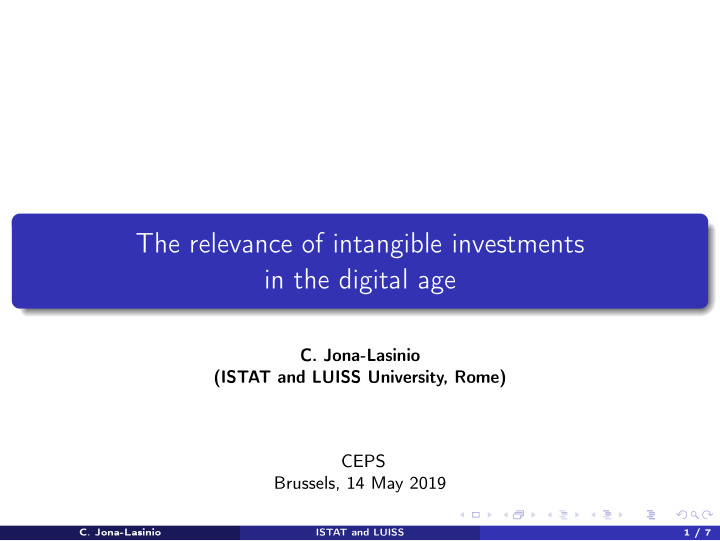



The relevance of intangible investments in the digital age C. Jona-Lasinio (ISTAT and LUISS University, Rome) CEPS Brussels, 14 May 2019 C. Jona-Lasinio ISTAT and LUISS 1 / 7
Background • Leading the economy successfully through fast changing markets requires new business models, great customer relations, competitive intelligence, agility, speed, and talent (Telstra Corporation Ltd and Deloitte tilted Taking Leadership in a Digital Economy). • Main finding: with the increasing expectation of having to deliver more with less - and the fact that digitisation accelerates those pressures - we need to invest in new capabilities not old business models. • Digitalization is expected to boost productivity growth enabling innovation and reducing the costs of a range of business processes (OECD, 2018). • Digitalization is changing business models so that firms are placing greater emphasis on intangible assets (OECD, 2018) • To realize the growth potential of innovations related to digitalization it is necessary to invest in intangible assets (Brynjolffson, Syverson, and Rock, 2017). C. Jona-Lasinio ISTAT and LUISS 1 / 7
Expanding the investment boundaries to include intangibles change the productivity perspective Does considering these investments help understand the ongoing transformation of the global economies and productivity trends? Source: Corrado, Haskel, Iommi, Jona-Lasinio (2016) C. Jona-Lasinio ISTAT and LUISS 2 / 7
Tangible and intangible investment trends: EU vs US By 2013, for every pound of investment in tangible assets, the major developed countries spent 1.10 pounds on intangible assets (Haskel and Westlake,2017) Note: EU aggregation uses Eurostat’s industry-specific production side PPPs. Source: INTAN-Invest c � 2018, available at www.intaninvest.net C. Jona-Lasinio ISTAT and LUISS 3 / 7
Tangible and intangible intensities differ across countries • Intangibles are outpacing tangibles in most of the advanced economies Note: Non Agricultural market sector excludes real estate. Source: INTAN-Invest c � 2018, available at www.intaninvest.net C. Jona-Lasinio ISTAT and LUISS 4 / 7
Digital intensity - VA shares • In more intangible intensive economies (UK, US, FI, FR, SW) HD intensive sectors are gaining more relevance. Shares of Total Value Added Country HD MD LD 2000-07 2010-15 2000-07 2010-15 2000-07 2010-15 Austria 25.8% 27.2% 42.7% 42.0% 31.6% 30.8% Belgium 33.6% 36.8% 40.5% 36.6% 25.9% 26.6% Germany 36.4% 36.6% 42.3% 41.3% 21.3% 22.1% Denmark 27.2% 31.5% 43.5% 43.2% 29.4% 25.3% Spain 25.9% 28.6% 38.2% 36.9% 40.2% 39.4% Finland 22.2% 26.9% 51.5% 44.4% 26.3% 28.7% France 35.6% 37.8% 37.1% 33.4% 27.3% 28.9% Italy 30.6% 32.1% 42.6% 39.2% 26.9% 28.7% Netherlands 37.1% 40.9% 38.6% 36.0% 24.3% 23.1% Sweden 32.3% 35.1% 41.3% 38.0% 26.4% 26.9% UK 36.8% 42.0% 36.4% 32.1% 26.9% 25.9% USA 35.3% 36.6% 42.5% 41.7% 22.2% 21.6% Source: Battiati, Jona-Lasinio, Sopranzetti (2019) C. Jona-Lasinio ISTAT and LUISS 5 / 7
Global Value Chain participation in the digital sectors • The correlation is stronger in the high digital sectors but the distribution is more dispersed after the financial crisis. Source: Battiati, Jona-Lasinio, Sopranzetti (2019) C. Jona-Lasinio ISTAT and LUISS 6 / 7
Main challenges • Investment in training and workforce skills are crucial to enable the digital transformation • Strengthen technology and knowledge diffusion is essential to benefit from digital transformations • The emergence of new business models (as well as new ways of delivering public and private services) requires new regulatory approaches in many areas (financial services, education services, public sector...) • All things digital suggest optimism for future productivity growth (R&D in ICT/AI/computing is very robust) C. Jona-Lasinio ISTAT and LUISS 7 / 7
Recommend
More recommend